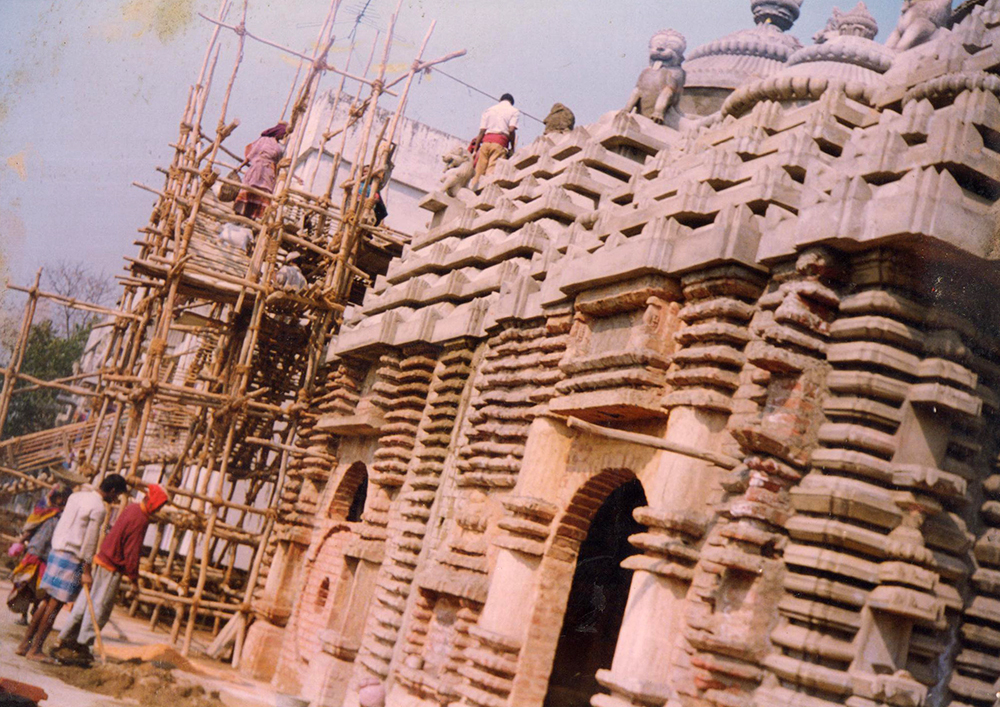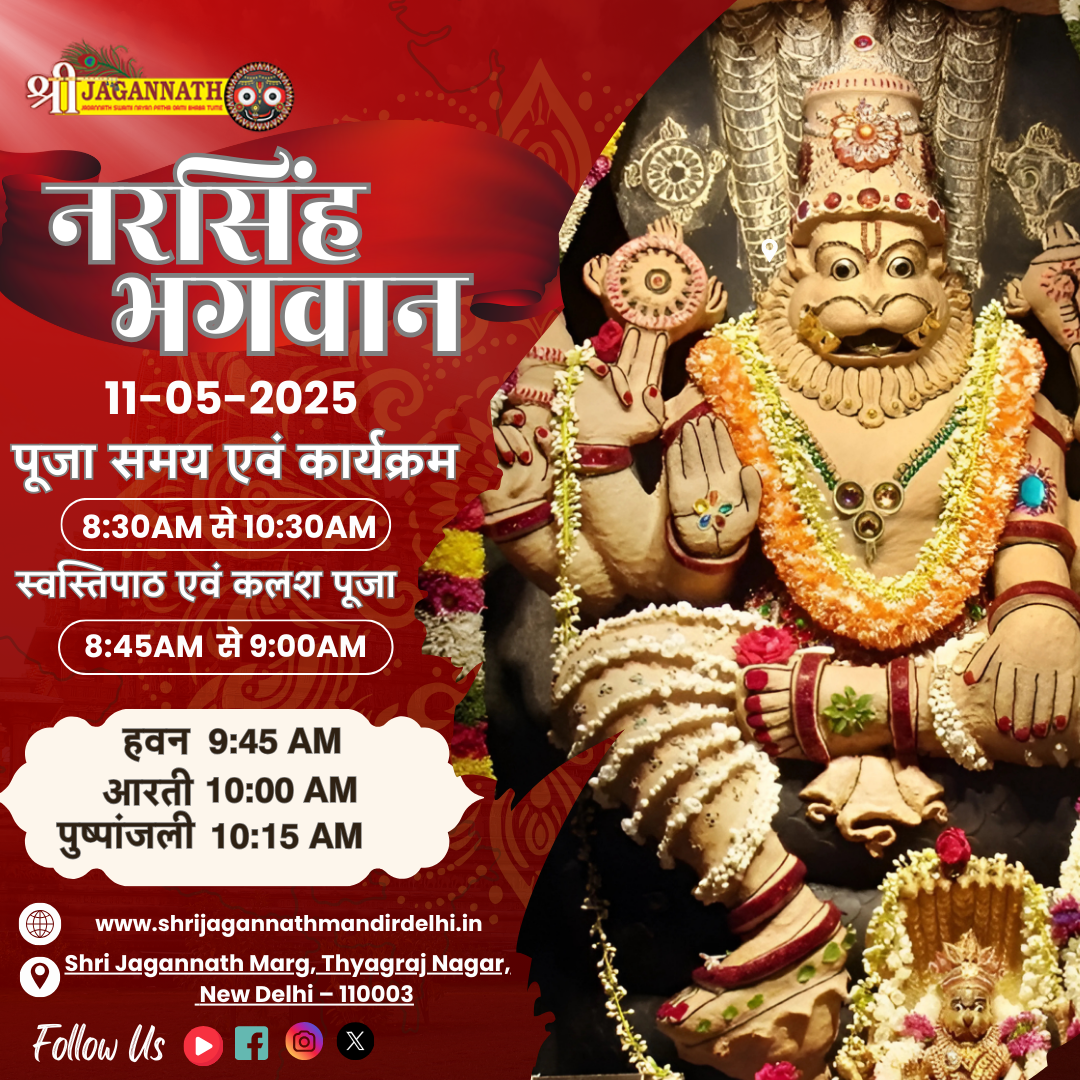Delhi, a city rich in history, culture, and spirituality, is home to several temples, each with its unique stories and significance. Among these sacred spaces stands the Shri Jagannath Mandir in Thyagraj Nagar, Delhi, one of the most revered temples dedicated to Lord Jagannath, a form of Lord Vishnu. This temple, established in 1968, not only holds deep spiritual importance for devotees but also stands as a historical testament to the connection between the city of Delhi and the spiritual practices rooted in Odisha, where the Jagannath culture originated.
The Spiritual Significance of Lord Jagannath
Lord Jagannath, often referred to as the Lord of the Universe, is a form of Lord Vishnu worshipped primarily in the Indian state of Odisha. The famous Jagannath Temple in Puri, Odisha, is one of the four Char Dham pilgrimage sites, attracting millions of devotees each year. The deities in the temple—Lord Jagannath, his sister Subhadra, and his elder brother Balabhadra—are symbolic of the eternal cosmic cycle and the idea of unity in diversity. Lord Jagannath is also known for his wooden idol, which is distinctively different from the traditional stone idols found in other temples.
Jagannath’s association with the Ratha Yatra (Chariot Festival), one of the largest religious processions in the world, further emphasizes the cultural and spiritual significance of this deity. The devotion to Lord Jagannath has extended beyond Odisha, with several temples dedicated to him spread across India, including the Shri Jagannath Mandir in Delhi.
A Glimpse into the History of Shri Jagannath Mandir, Thyagraj Nagar
The Shri Jagannath Mandir in Thyagraj Nagar, established in 1968, is considered the oldest Jagannath temple in the city. Founded with the vision of bringing the spirit and devotion of Lord Jagannath to Delhi, this temple has grown to become an important religious center in the city. The temple was built to serve not only as a place of worship but also as a hub of cultural and social activities, making the teachings of Lord Jagannath accessible to a wider audience.
As per the temple’s history and vision, the temple was created with the aspiration to create a center for spiritual growth, cultural development, and community welfare. It aims to provide a platform where people can engage in acts of devotion, share in the cultural practices of Odisha, and partake in philanthropic endeavors. The temple also seeks to instill the message of unity, compassion, and the inclusive nature of Lord Jagannath’s teachings.
Architecture and Design of the Temple
The architecture of the Shri Jagannath Mandir in Thyagraj Nagar is an embodiment of traditional Odisha temple design, with some unique features that reflect the craftsmanship of the region. The structure includes a sanctum sanctorum (garbhagriha) housing the idols of Lord Jagannath, Balabhadra, and Subhadra. The temple’s towering Shikhara (spire) is designed in the classic style of the Jagannath Temple in Puri, though it is adapted to fit the local environment and urban setting of Delhi.
The temple’s outer walls are adorned with carved stone depictions of various deities and mythological stories, drawing from the rich cultural and religious traditions of Odisha. The temple’s sanctum is a serene, meditative space where devotees come to offer prayers, perform rituals, and seek blessings.
The Religious and Cultural Importance
Shri Jagannath Mandir holds great religious importance for people of all ages and backgrounds, especially those with roots in Odisha. It serves as a hub for religious activities and cultural celebrations. Regular prayers, bhajans, and kirtans are held to honor Lord Jagannath, creating an atmosphere of spiritual serenity.
As mentioned in the temple’s vision, the Mandir focuses on fostering a strong sense of community, cultural heritage, and devotional practice. It encourages devotees to participate in the religious, spiritual, and social welfare programs organized throughout the year. Major festivals such as Ratha Yatra, Janmashtami, Navaratri, and Diwali are celebrated with special poojas, feasts, and community gatherings. The temple also organizes satsangs, bhakti programs, and spiritual discourses, which help devotees gain a deeper understanding of the philosophy of devotion and the teachings of Lord Jagannath.
Rituals and Daily Pujas
The daily operations of Shri Jagannath Mandir follow the traditional rituals of Puri’s Jagannath Temple, adapted for the urban setting of Delhi. The rituals are conducted by a team of priests who are well-versed in the traditions of the Jagannath cult. These daily prayers include the Mangala Aarti, Rajbhog Aarti, and Sandhya Aarti, along with offerings of prasad to the deities. Devotees visit the temple throughout the day to seek the blessings of Lord Jagannath and his siblings.
One of the most iconic offerings at the temple is the Mahaprasad, a sacred food offering that is prepared and distributed to devotees after it has been offered to the deities. This food is considered to be highly auspicious and is believed to bring divine blessings. The prasad typically consists of rice, dal, vegetables, and sweets, which are prepared in a large-scale kitchen known as the Ananda Bazar.
Community and Social Impact
Apart from its religious significance, Shri Jagannath Mandir also plays a crucial role in the social fabric of Thyagraj Nagar and beyond. The temple is actively involved in various charitable initiatives and social welfare activities. As mentioned in the temple’s vision, it places a strong emphasis on seva (service), particularly through food distribution programs, medical assistance, and educational outreach efforts. During festivals and other occasions, the temple organizes community meals (langar), offering free food to thousands of people, irrespective of their caste, creed, or religion. These meals promote a sense of inclusivity and community spirit.
The temple also contributes to the cultural growth of the local area by organizing educational and cultural programs, such as traditional dance performances, music recitals, and art exhibitions that focus on Odisha’s rich cultural heritage. By providing a platform for local artists and performers, the temple helps preserve and promote the cultural arts of Odisha.
The Growing Influence and Future Prospects
Over the years, Shri Jagannath Mandir has gained immense popularity not only within the local community but also across Delhi. The temple has grown from a small place of worship to a major center for cultural and religious activities, attracting devotees from all over Delhi. As the temple moves into the future, there are plans to modernize some of its facilities while retaining its traditional ethos. This includes expanding the temple’s outreach programs, organizing more community services, and enhancing the overall visitor experience.
Conclusion
The Shri Jagannath Mandir in Thyagraj Nagar, established in 1968, stands as a living testament to the enduring power of faith, culture, and tradition. It is not only a place of worship but also a community center where spiritual growth and cultural heritage intersect. The oldest Jagannath Temple in Delhi is more than just a place of prayers; it is a symbol of the deep-rooted devotion of the people, a center for cultural exchange, and a sanctuary of peace. As it continues to evolve, the temple remains a beacon of hope, love, and unity for all who seek the divine blessings of Lord Jagannath.
For more details on the temple’s history, mission, and ongoing efforts, visit their official page.













